7 Minutes
Researchers have recreated a Martian mystery in the lab: blocks of frozen carbon dioxide appear to burrow through sand, carving narrow gullies on dune slopes. These striking landforms—once mistaken for signs of biological activity—can be produced by fast sublimation and gas-driven blasting under Martian conditions.
When Frozen Carbon Dioxide Becomes a Geological Sculptor
On Earth, gullies are most often linked to flowing water or the action of living organisms. On Mars, however, a different actor takes the stage: seasonal CO2 frost. In experiments led by Dr. Lonneke Roelofs of Utrecht University and published in Geophysical Research Letters, blocks of solid carbon dioxide were shown to dig into, displace and slide through sand while sublimating—transitioning directly from solid to gas. That sublimation generates pressurized gas pockets that blast sand away, allowing the ice blocks to burrow downhill and leave behind narrow, leveed trenches closely resembling gullies photographed by orbital cameras such as HiRISE.
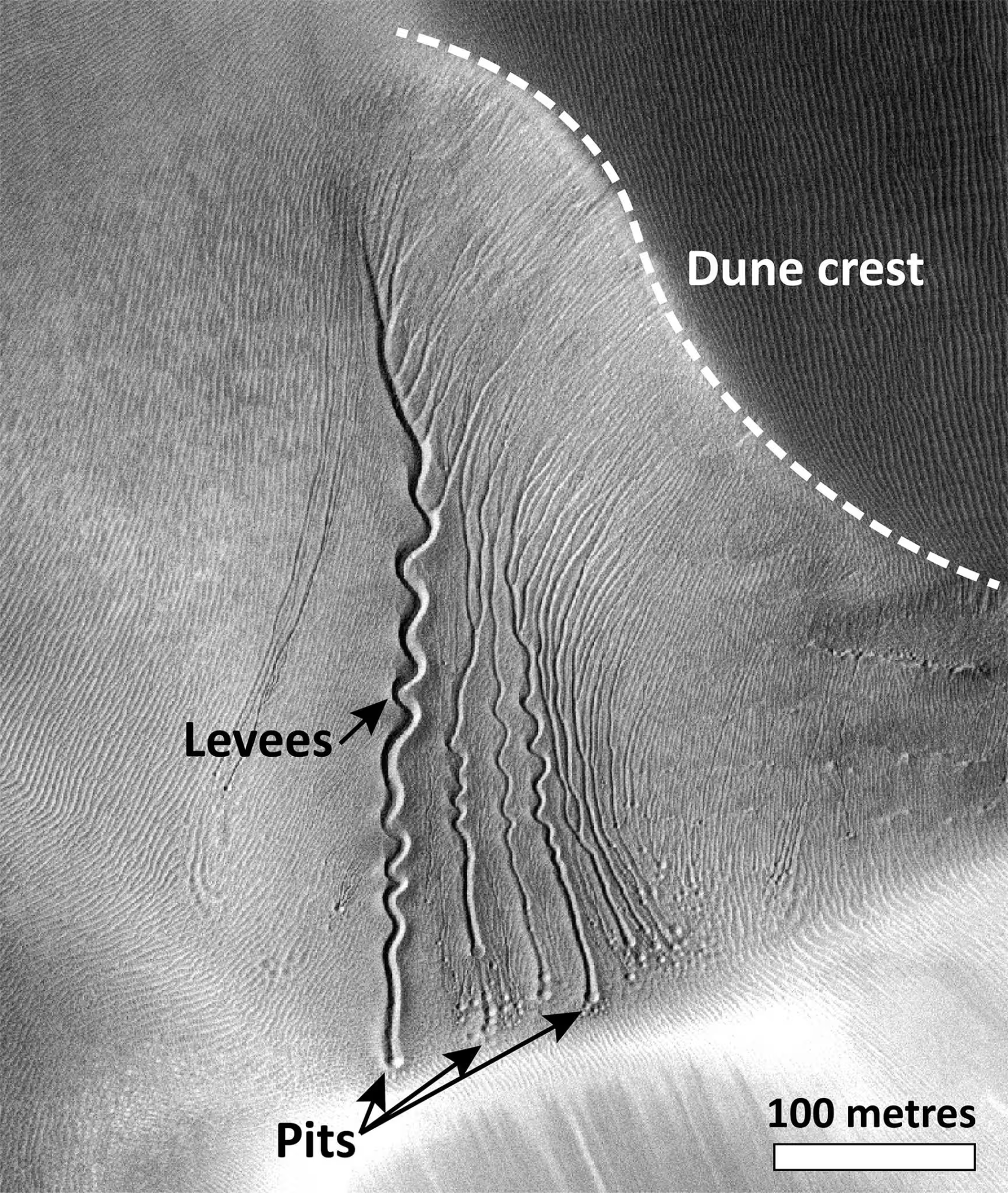
How Sublimation Drives Movement and Erosion
Mars’ thin atmosphere and extreme temperature swings create conditions rare on Earth. During the Martian winter, dunes across some southern hemisphere fields accumulate CO2 frost—layers that can become tens of centimeters thick. When spring sunlight warms the dune surface, the underside of detached CO2 blocks vaporizes quickly. Because gas occupies far more volume than the same material in solid form, rapid sublimation builds local pressure under and around the block.
“In our simulation, I saw how this high gas pressure blasts away the sand around the block in all directions,” Roelofs explains. The block then settles into a hollow and, as sublimation continues, is nudged downhill by gas jets and gravity. The escaping gas mobilizes sand into levees along both sides of the track while the block carves a narrow trench. Repeat that process across many dunes and seasons, and you get networks of winding gullies that can look alarmingly like traces left by living burrowers.
The Laboratory Replay: The Mars Chamber Experiment
To test the hypothesis, Roelofs and master student Simone Visschers used a Mars simulation chamber at the Open University in Milton Keynes. Financial support from the British Society of Geomorphology helped fund the visit. Inside the chamber they recreated low pressure, cold temperatures and the granular dune slopes necessary to observe realistic interactions between CO2 ice blocks and sand.
They varied slope angles and dropped metre-scale CO2 blocks onto modeled dune faces. Only under particular slope and substrate conditions did the blocks begin to dig and slide, producing narrow, sinuous channels with small levees—morphologies that map closely to HiRISE images taken of actual Martian dunes.
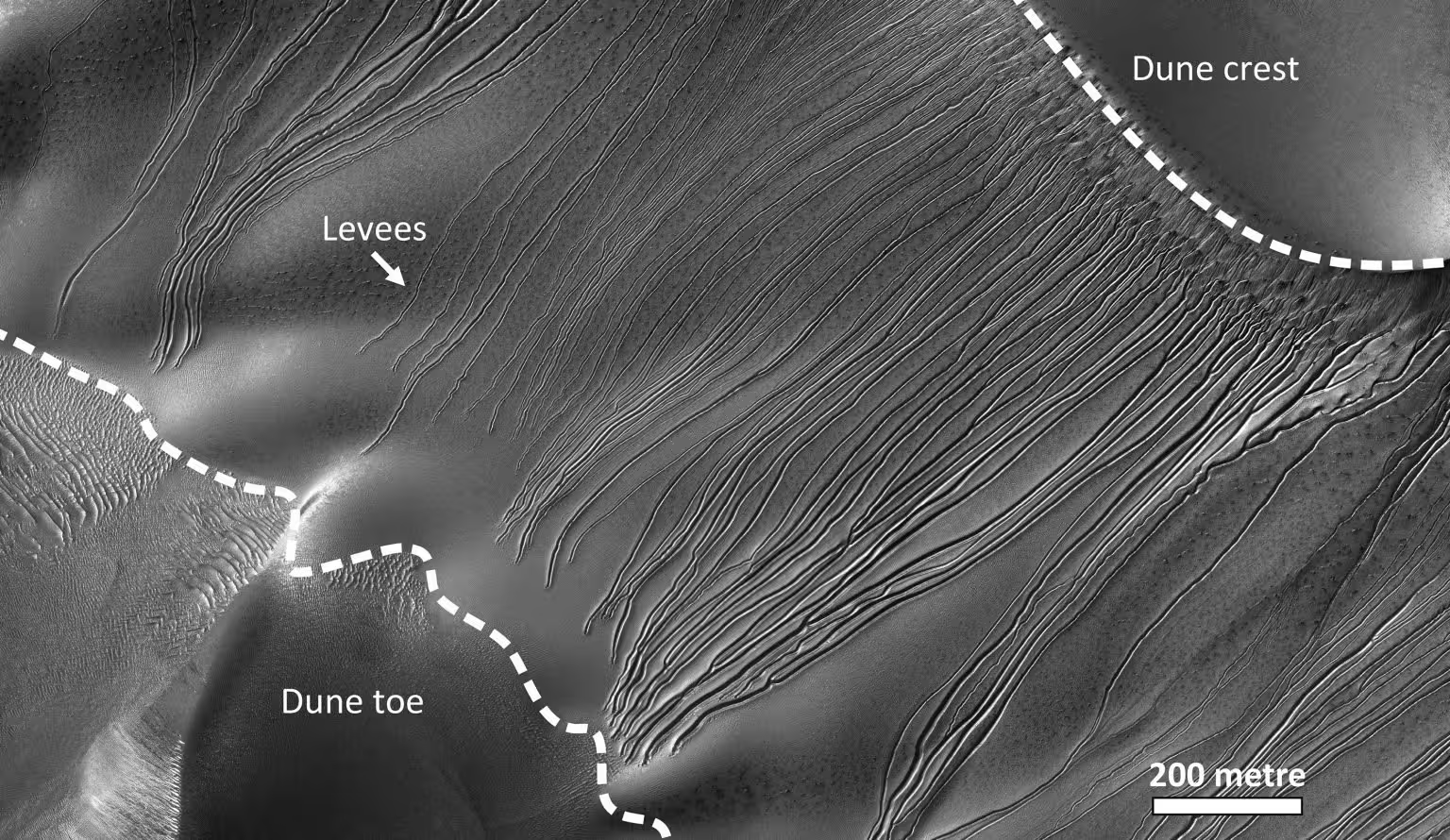
Mars dune with gullies in the Russell crater. On their way down, the ice blocks threw up levees. Credit: Image taken by HiRISE (PSP_001440_1255_RED), NASA/JPL/University of Arizona
Where Do the Blocks Come From?
Field observations and the experiments together point to a seasonal origin. A continuous CO2 frost mantle forms across dune fields in winter, sometimes growing up to ~70 cm thick. In spring, the last deposits cling on the shaded sides of dune crests. Rising temperatures cause those remnants to weaken and fracture into blocks that can detach and roll downslope. As they move, sustained sublimation under the block produces the gas-driven excavation and lateral levees seen in both laboratory and orbital imagery.
After the ice fully sublimates, what remains is a hollow at the base of the dune—a signature feature found in many Martian gully systems photographed by orbiters.
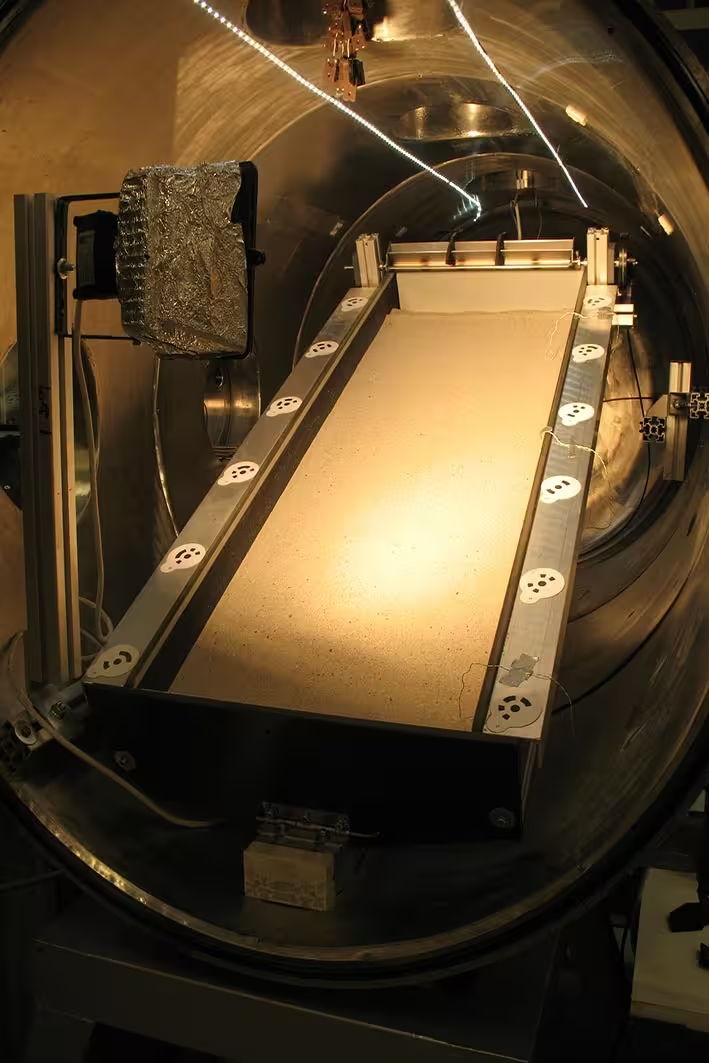
The setup prior to the experiment in the Mars Chamber. Credit: Lonneke Roelofs/Utrecht University
Why This Changes How We Read the Martian Surface
For decades, planetary scientists have debated whether certain gullies on Mars point to transient liquid water, dry granular flows, CO2-driven debris flows, or even biological activity. Demonstrating that sublimating CO2 blocks can reproduce narrow dune gullies clarifies one mechanism by which the Red Planet reshapes itself without liquid water. It emphasizes the role of non-terrestrial physics—low atmospheric pressure combined with CO2 phase changes—in producing landforms that may superficially resemble Earth analogues.
These insights are important for interpreting Mars’ climate and seasonal cycles, assessing past habitability, and planning rover traverses. For example, recognizing a gully’s CO2-driven origin reduces its priority as a potential former aqueous habitat, while highlighting dynamic surface processes that could affect rover safety or scientific sampling.
.avif)
After the experiment, when the CO2 ice (still visible at the bottom) has left a trail through the sand, with the characteristic levees on the sides of the gully. The bend in the gully is probably due to a small disturbance in the sand bed. Credit: Lonneke Roelofs/Utrecht University
Scientific Context and Broader Implications
Roelofs’ work builds on previous studies that implicated CO2 sublimation in other Martian mass-wasting events, such as seasonal gas-lubricated debris flows on crater walls. This experiment isolates the action of discrete blocks and shows how a once-unexpected mechanism can leave persistent geomorphic traces. By expanding the catalog of abiotic processes that shape Mars, the research helps refine models of surface erosion, sediment transport, and landscape evolution under Martian pressures and temperatures.
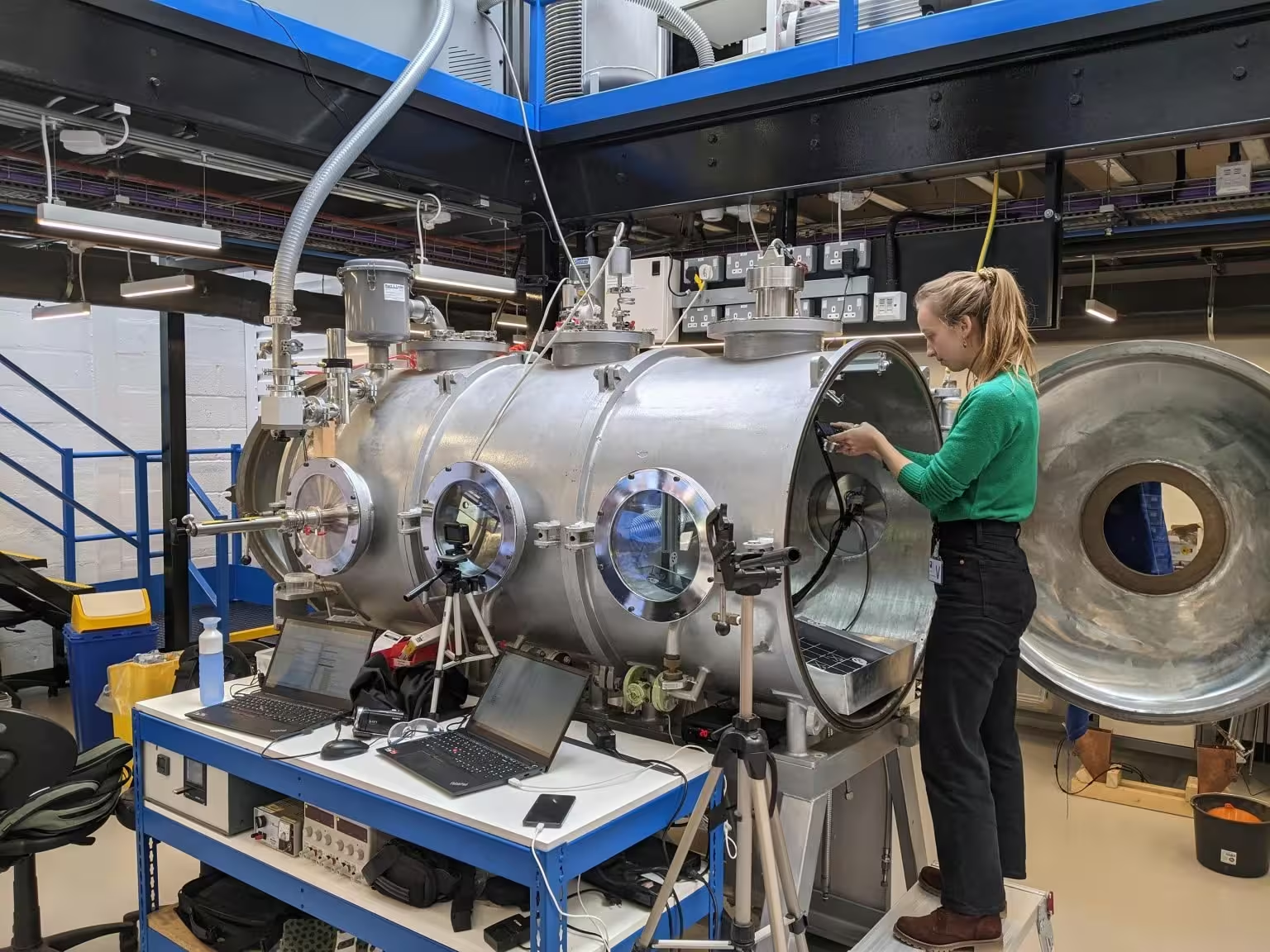
Dr. Lonneke Roelofs preparing her experiments in the Mars Chamber. Credit: Lonneke Roelofs/Utrecht University
Expert Insight
“This work is a great example of how planetary physics can produce features that look biological but are entirely abiotic,” says Dr. Mira Sato, a planetary geomorphologist not involved with the study. “Understanding CO2-driven erosion helps us correctly interpret gully morphology across Mars and prioritize targets for future landers and rovers. It also reminds us that alien environments can leverage familiar materials—like sand and ice—in unfamiliar ways.”
What Comes Next for Mars Gully Research?
Future steps include higher fidelity simulations, more precise measurements of gas pressures during sublimation, and targeted orbital monitoring of dune fields across seasons. Coordinated observations from instruments like HiRISE and data from upcoming missions can test predictions about where CO2-block gullies should form and how they evolve year-to-year. On the technological side, improved laboratory chambers and granular flow sensors will help quantify forces involved in gas-driven erosion—a process absent from Earth-based geomorphology.
Why does Mars continue to fascinate? Because it forces us to rethink processes we take for granted on Earth. Studies such as Roelofs’ expand our toolkit for reading planetary surfaces, refining the line between processes that could indicate past water or life and those produced by the peculiar physics of the Red Planet.
Source: scitechdaily
Comments
skyspin
Could these lab runs really rule out past water activity? Seems plausible, but maybe not the whole story… hmm
astroset
wow that is wild!! CO2 blocks burrowing like critters? Mars keeps getting weirder lab tests matching HiRISE pics, nice

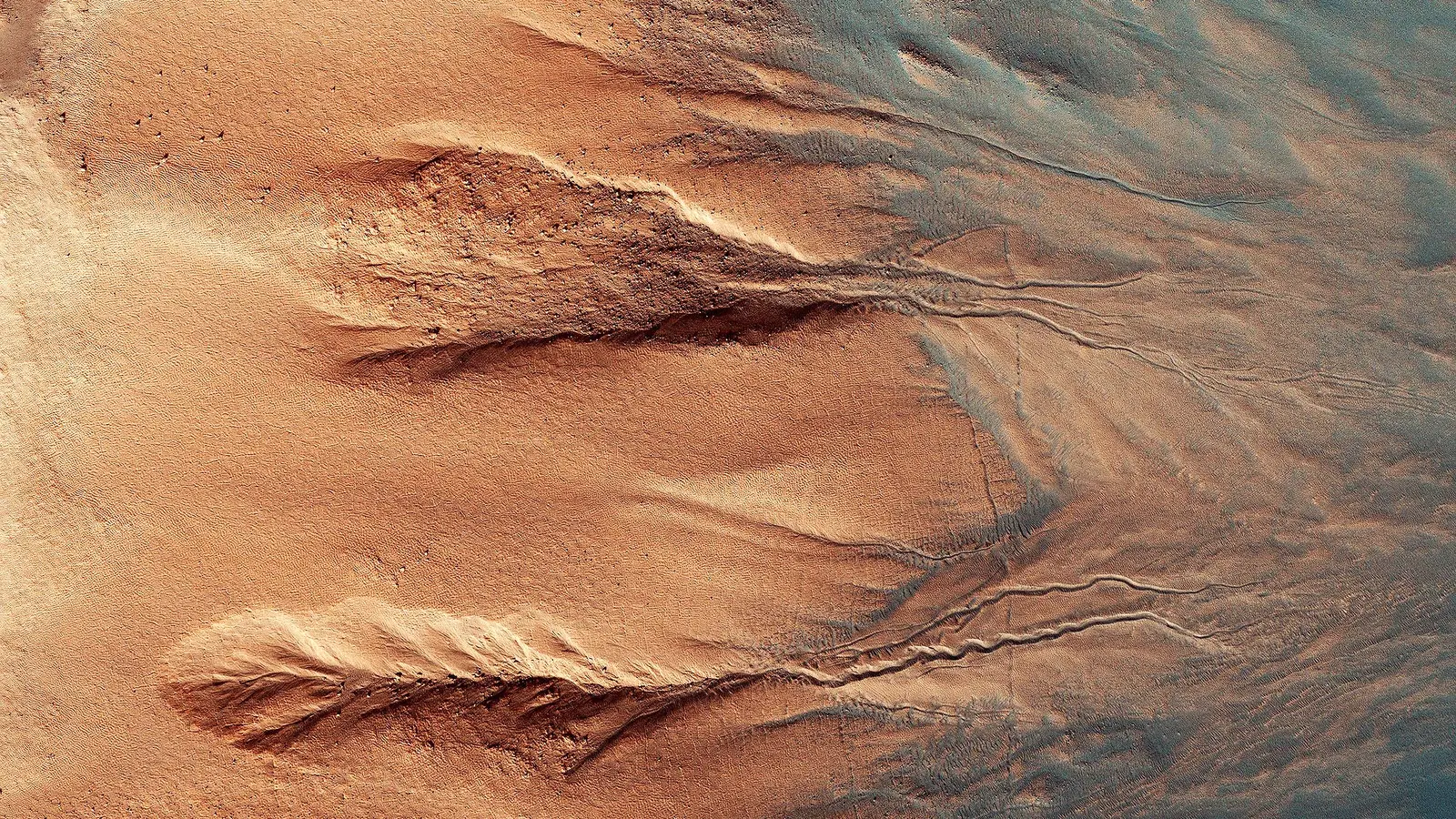
Leave a Comment